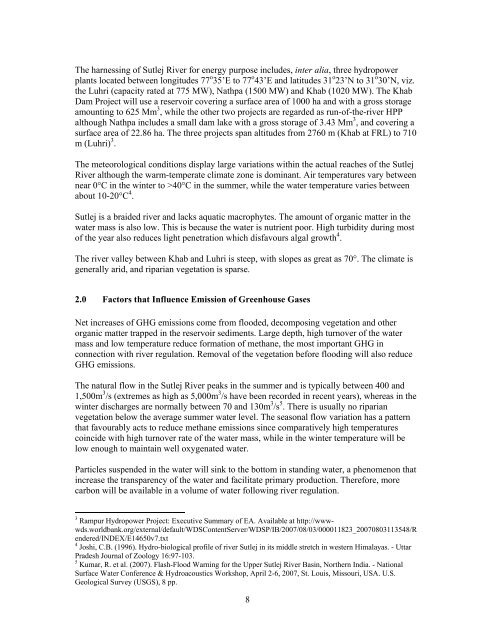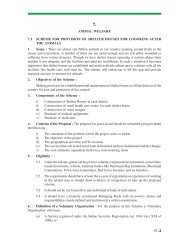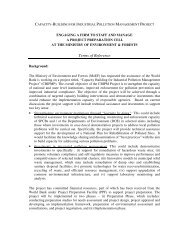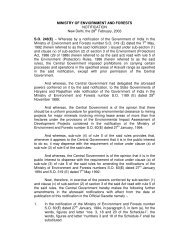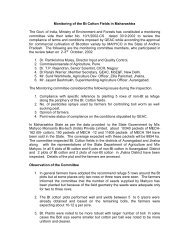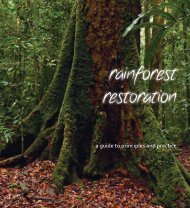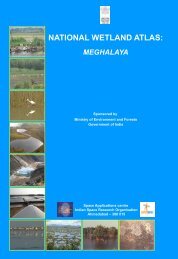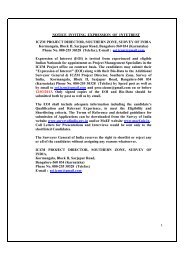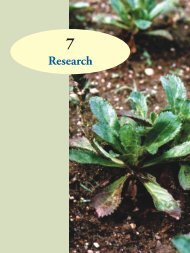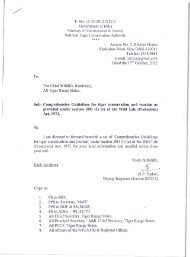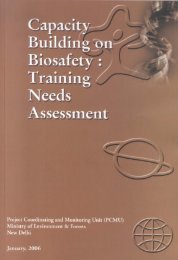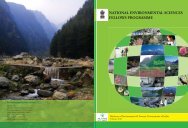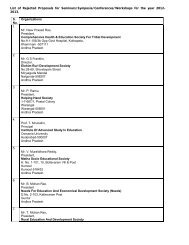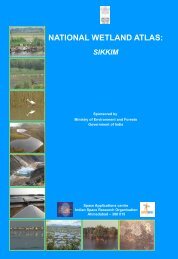REVIEW OF GREENHOUSE GAS EMISSIONS FROM THE ...
REVIEW OF GREENHOUSE GAS EMISSIONS FROM THE ...
REVIEW OF GREENHOUSE GAS EMISSIONS FROM THE ...
You also want an ePaper? Increase the reach of your titles
YUMPU automatically turns print PDFs into web optimized ePapers that Google loves.
The harnessing of Sutlej River for energy purpose includes, inter alia, three hydropowerplants located between longitudes 77 o 35’E to 77 o 43’E and latitudes 31 o 23’N to 31 o 30’N, viz.the Luhri (capacity rated at 775 MW), Nathpa (1500 MW) and Khab (1020 MW). The KhabDam Project will use a reservoir covering a surface area of 1000 ha and with a gross storageamounting to 625 Mm 3 , while the other two projects are regarded as run-of-the-river HPPalthough Nathpa includes a small dam lake with a gross storage of 3.43 Mm 3 , and covering asurface area of 22.86 ha. The three projects span altitudes from 2760 m (Khab at FRL) to 710m (Luhri) 3 .The meteorological conditions display large variations within the actual reaches of the SutlejRiver although the warm-temperate climate zone is dominant. Air temperatures vary betweennear 0°C in the winter to >40°C in the summer, while the water temperature varies betweenabout 10-20°C 4 .Sutlej is a braided river and lacks aquatic macrophytes. The amount of organic matter in thewater mass is also low. This is because the water is nutrient poor. High turbidity during mostof the year also reduces light penetration which disfavours algal growth 4 .The river valley between Khab and Luhri is steep, with slopes as great as 70°. The climate isgenerally arid, and riparian vegetation is sparse.2.0 Factors that Influence Emission of Greenhouse GasesNet increases of GHG emissions come from flooded, decomposing vegetation and otherorganic matter trapped in the reservoir sediments. Large depth, high turnover of the watermass and low temperature reduce formation of methane, the most important GHG inconnection with river regulation. Removal of the vegetation before flooding will also reduceGHG emissions.The natural flow in the Sutlej River peaks in the summer and is typically between 400 and1,500m 3 /s (extremes as high as 5,000m 3 /s have been recorded in recent years), whereas in thewinter discharges are normally between 70 and 130m 3 /s 5 . There is usually no riparianvegetation below the average summer water level. The seasonal flow variation has a patternthat favourably acts to reduce methane emissions since comparatively high temperaturescoincide with high turnover rate of the water mass, while in the winter temperature will below enough to maintain well oxygenated water.Particles suspended in the water will sink to the bottom in standing water, a phenomenon thatincrease the transparency of the water and facilitate primary production. Therefore, morecarbon will be available in a volume of water following river regulation.3 Rampur Hydropower Project: Executive Summary of EA. Available at http://wwwwds.worldbank.org/external/default/WDSContentServer/WDSP/IB/2007/08/03/000011823_20070803113548/Rendered/INDEX/E14650v7.txt4 Joshi, C.B. (1996). Hydro-biological profile of river Sutlej in its middle stretch in western Himalayas. - UttarPradesh Journal of Zoology 16:97-103.5 Kumar, R. et al. (2007). Flash-Flood Warning for the Upper Sutlej River Basin, Northern India. - NationalSurface Water Conference & Hydroacoustics Workshop, April 2-6, 2007, St. Louis, Missouri, USA. U.S.Geological Survey (USGS), 8 pp.8


